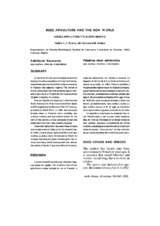Mostrar el registro sencillo del ítem
Bees, apiculture and the new world
| dc.contributor.author | Puerta Puerta, F. | es_ES |
| dc.contributor.author | Padilla-Alvarez, F. | es_ES |
| dc.contributor.author | Bustos Ruiz, M. | es_ES |
| dc.contributor.author | Flores Serrano, J.M. | es_ES |
| dc.date.accessioned | 2010-05-17T08:07:09Z | |
| dc.date.available | 2010-05-17T08:07:09Z | |
| dc.date.issued | 1992 | |
| dc.identifier.issn | 1885-4494 | |
| dc.identifier.uri | http://hdl.handle.net/10396/3305 | |
| dc.description.abstract | In the New World, some stingless bees were kept by the native population. In Central America, maya beekeepers worked with Mellipona beecheii, in Yucatan and adjacent regions. The arrival in North America of the first beehives was in 1691 and it were sent to Virginia by the Council of the Virginia Company in London. Concerning the introduction to Central and South America the first ones arrived from Spain and Portugal towards the end of the 18th century, probably to Brazil. Prior to 1800, the european breeds taken to America were probably Apis mellifera mellifera and Apis mellifera iberica. At the turn of the century, a new european breed was imported from Italy (Apis mellifera ligustica). American apiculture has used these breeds and crossbreeds virtually up to the present day. In 1956, tropical african queens of the breed Apis mellifera scutellata were introduced to Brazil. Its crosses involving european breeds gave rise to africanized bees, which have spread over almost the whole of South, Central and North America. | en |
| dc.description.abstract | Los nativos del Nuevo Mundo utilizaban algunas abejas sin aguijón. En América Central los apicultores mayas trabajaron, en el Yucatán y regiones adyacentes, con Mellipona beecheii. Los nativos del Nuevo Mundo utilizaban algunas abejas sin aguijón. En América Central los apicultores mayas trabajaron, en el Yucatán y regiones adyacentes, con Mellipona beecheii. La llegada a América del Norte de las primeras colmenas se produjo en 1691. Fueron enviadas a Virginia desde Inglaterra por la Virginia Company. Las primeras colmenas enviadas a América Central y del Sur, probablemente a Brasil, a finales del siglo XVIII, procedían de España y Portugal. Antes de 1800 las razas europeas llevadas a Amé-rica fueron, probablemente, Apis mellifera mellifera y Apis mellifera iberica. A fin de siglo se introduce otra (Apis mellifera ligustica) procedente de Italia. La apicultura americana ha empleado las razas mencionadas y sus cruces, hasta nuestros días. En 1956 se introdujeron en Brasil reinas de Apis mellifera scutellata, procedentes de Africa tropical. Las abejas procedentes de su cruce con razas europeas, “africanizadas”, se han extendido por casi la totalidad del continente americano. | es_ES |
| dc.format.mimetype | application/pdf | es_ES |
| dc.language.iso | eng | es_ES |
| dc.publisher | Universidad de Córdoba, Servicio de Publicaciones | es_ES |
| dc.rights | https://creativecommons.org/licenses/by-nc-nd/4.0/ | es_ES |
| dc.source | Archivos de zootecnia 41 (154), 563-567 (1992) | es_ES |
| dc.subject | Apicultura | es_ES |
| dc.subject | América | es_ES |
| dc.subject | Colonización | es_ES |
| dc.subject | Apis mellifera | es_ES |
| dc.title | Bees, apiculture and the new world | en |
| dc.title.alternative | Abejas, apicultura y el nuevo mundo | es_ES |
| dc.type | info:eu-repo/semantics/article | es_ES |
| dc.relation.publisherversion | http://www.uco.es/organiza/servicios/publica/az/az.htm | es_ES |
| dc.rights.accessRights | info:eu-repo/semantics/openAccess | es_ES |

